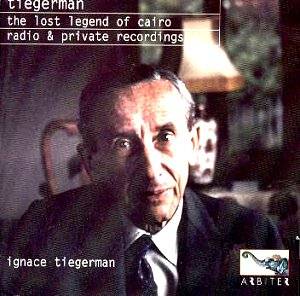Part detective story, part historical reclamation,
this double CD contains surviving recordings made by Leschetizky pupil
Ignace Tiegerman. The story of his wanderings – he ended up in Cairo
– is no less extraordinary than the lattice of contacts, friends, colleagues,
relatives and survivors that led to the discovery of these discs and
tapes. None were made for commercial purposes; they are private or off-air
and the bulk made in Cairo (though some date from an Italian trip and
are in significantly better sound).
Tiegerman was born in February 1893 and auditioned
for Leschetizky when he was barely ten. Four years’ study followed as
did further work with the eminent pedagogue’s assistant, none other
than Ignaz Friedman. He seems not to have cultivated a big career in
central Europe – though he’s reputed to have unnerved even so great
a pianist as Horowitz, who routinely mocked putative rivals but not
Tiegerman. Physical problems – bronchial asthma – and the worsening
political climate led him to leave Europe and on Friedman’s advice he
went to Egypt where he opened the Tiegerman Conservatoire. His life
thenceforth concentrated mainly on pedagogic activity interspersed with
recitals and the occasional concerto performance but even in Cairo he
wasn’t to remain untroubled and the encroaching German North African
advance saw him on the move again – this time, in 1941, he left for
the Sudan. His return necessitated surmounting the later increasing
domestic pressures in Egypt, which he seems to have done with phlegmatic
courtesy. Occasional visitors appeared – Bruce Hungerford for one struck
up a friendship with him but by the time of Tiegerman’s death, in 1968,
it’s fair to say that he had been pretty much a forgotten man for nearly
forty years.
As for the recordings some were made by the conductor
Oreste Campisi in Italy in 1966, two years before the pianist’s death.
These are in fine sound and allow one competently to judge Tiegerman’s
mechanical and tonal qualities at the age of seventy-three. Others come
from his final concerto performance in 1963 – the Franck and Saint-Saëns
– and yet more were recorded ad hoc, as he played for students and admirers.
As befits a Leschetizky student, warmth and pliancy of phrasing predominate
and are conspicuous features of his pianism. Enough aural material remains
to substantiate the belief that he maintained a tenacious adherence
to his teacher’s precepts and that his post mortem status has not been
inflated.
Brahms’s Capriccio is full of rhythmic sophistication
and the B flat minor Intermezzo full of tonal nuance and flexibility;
both were Italian recordings. The Saint-Saëns Egyptian Concerto
- a final salute from a wanderer to the country he made his home –was
part of his farewell concert of 1 June 1963. It’s survived in a rather
poor off-air recording with a distractingly bad orchestra, the resident
Cairo Symphony, but ones ears should be on Tiegerman. Amidst his very
audible groans and the occasional aural distortions he essays some glittering
runs, drenched in colour and light, whereas the rapt stillness of the
Andante finds a poet at the keyboard. No less than another elite Leschetizky
pupil, his near contemporary Moiseiwitsch (who as boys may well have
met in their teacher’s classes), Tiegerman was alert to the crystalline
and to the vivacious spirit that drives Saint-Saëns’ concertos.
In Brahms’ Romance in F one can admire the poetic depth of his chording
that even some queasy overloading can’t quite efface.
The two surviving movements of Brahms’ B flat Concerto
attest to Tiegerman’s earlier fiery reputation. Indeed this is combustible
playing, one that sweeps up its romantic tracery into a powerful vortex.
Stormy and directional, with some memorable pointing the Allegro non
troppo takes on monumental proportions but not ones that are motivated
by speed or indifference (vide Horowitz). His passagework is frequently
coruscating, his technique impressively intact, his phrase-leaning of
incisive imagination. Yes there are momentary pitch drops, yes the trumpets
blare but the force that compels is Tiegerman’s alone. Nothing is trivialised,
no matter how extreme the drive, and even the few dropped notes attest
to the strongly directional aim of the performance. The speciously rhetorical
had no place in Tiegerman’s armoury – he is part of the orchestral fabric
and binds the solo part to it. The Allegro Appassionato once again has
marvellous drive and a feeling of intense – but not unduly introspective
– concentration. How frustrating that the final two movements have not
survived but how lucky that we can hear those that have - and to hear
Tiegerman’s leonine power in this of all works.
His Field is delicate and tonally beautiful and he
plays a lot of Chopin as well. I particularly admired the Nocturne in
B, which is phrased with real delicacy, and the Ballade in F minor,
which is laced with drama and intensity, pitch drops notwithstanding.
The Third Sonata is from a radio broadcast but despite the aural limitations
we can hear a Chopin master at work; nobility, grandeur and sensitivity
in the opening Allegro maestoso, rapid clarity of fingers in the scherzo
– where for all the motoric imperative there is concomitant evenness
and beauty of tone and colour. I found less to admire in his Fauré,
the Nocturne in E flat emerging as rather leaden, metrical and cold.
Otherwise much else repays the closest scrutiny. A
major figure has been finally accorded the justice that in life escaped
him. The relative primitiveness of the recordings are, believe me, a
price worth paying. The notes by Allan Evans are fascinating and the
whole production an inspiring dual act of Hommage and reclamation.
Jonathan Woolf


